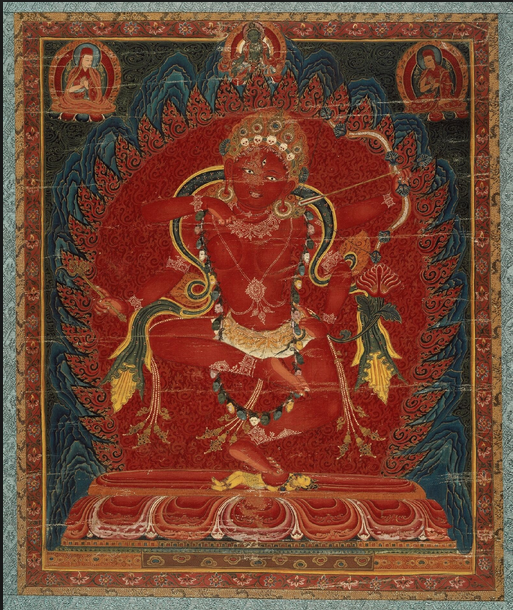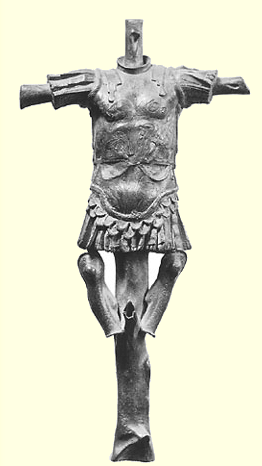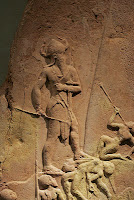The double Goddess of war.
Before the battle.
The Spartans sacrificed a female goat to Artemis Agrotera...
After the battle, a helmet, a shield, and a spear taken from the enemy would be set upon a wooden stake, to start the repair of the disorder of war by laying out the symbolic 'bones' of the dead in the form of the tropaion.
After the battle
The goat skin would be wrapped around the trophy: the aeigis placed upon the tropaion.
And the tropaion became Athena.
Artemis to Athena.
Neither Goddess is usually connected directly to war, or known as a Goddess of war, and yet here is a clear example of their connection to it.
Where to begin!
Pausanias wrote of a temple to Artemis at Agrae on the Ilissos [link] 5th century BC.
Plutarch and Aristophanes describe goat sacrifice: during the Boedromia, on the seventh day of Boedromion (roughly, the beginning of September), an armed procession would take 600 goats to this temple, where they would all be sacrificed by a warlord in honour of the victory at the Battle of Marathon...
The Spartans were at Marathon..
Anyway, the number of goats to be sacrifices was supposed to equal the number of Persian warriors slain, but as this would have been too many, the number was reduced to a mere 500 or so.
Forget about the number of goats!
Xenophon said it was just 90!
Forget the goats!
Start again.
Before setting off to war the army sacrificed many animals at the sanctuary of Hyakinthides in full view of the enemy before battle began...The Hyakinthides bear a name very similar to Hyacinth, but let's forget about that too.
The Hyakinthides were the daughters of Erectheus, king of Athens.
When Athens was at war with Eleusis, or as another story tells it, when Athens was sent plague by Zeus, the two girls went willingly to their death to save the lives of the people of their city...the name of their father is sometimes given as Hyakinthos, not Erectheus.
In Euripides play 'Erectheus' (not much of which, remains!) Athena institutes sacred dances and festivals to honour the girls. One of these is called the Orthaia. And Artemis had a temple in Sparta, or rather Artemis Orthaia had a temple which, again Pausanius describes:
Pausanias:
Reading between the lines, a wooden statue was found depicting a goddess and it sent people mad!
Euripides sends Iphigenia to the land of the statue's origin in 'Iphegenia in Tauris' instead of having her sacrificed to Artemis by her father before the battle of Troy.
Eventually
The blood was offered via scourging...
Trying to get to the cheese!
During the Roman period, according to Cicero, the ritual of cheese on the alter and whipping people trying to take it became a blood spectacle, sometimes to the death, with spectators from all over the empire. An amphitheatre had to be built in the 3rd century CE to accommodate the tourists. Libanios indicates that the spectacle was attracting the curious as late as the 4th century CE.
And you know what, it would still work!
But going back
Forget about cheese whipping, goats and Hyacinths..
The theme here is the sacrifice of girls to Artemis, in order to summon disorder followed by restoration and the transformation into order, the presence of Athena. The goat is sacrificed to begin the killing. The goat's death is a precursor to more killing; the sight of blood, the female goat a symbol perhaps of domesticity, of women, of girls, of vulnerability (the emotional vulnerability of the men) and when it is all over, the goat skin turns the tropian into Athena.
The transformation of Artemis into Athena recalls the relationship between Ereshkigal and her sister, Inana.
As if blood and death belong to Artemis, as ultimately they belong to Ereshkigal and order is restored under the protection of Athena/ Inana/Ishtar..
Inana is described as a 'war god' mainly I guess because she is not what nice classical scholars thought of as feminine, she wasn't the Virgin Mary!
In battle, I am your leader
In combat, I am your armour-bearer
In the assembly, I am your advocate
n the campaign, I am your inspiration
You, the chosen shepherd of the holy shrine
You, the king, the faithful provider of Uruk,
You, the light of An's great shrine
In all ways you are fit
To hold your head high on the lofty dais
To sit on the lapis lazuli throne
To cover your head with the holy crown
To wear long clothes on your body
To bind yourself with the garment of kingship
To race on the road with the holy sceptre in your hand
And the holy sandals on you feet
You, the sprinter, the chosen shepherd
In all ways I find you fit
May your heart enjoy long days.
That which An determined for you - may it not be altered
That which Enlil has granted - may it not be altered
You are the favourite of Ningal
Inanna holds you dear.'
Words like this, authorizing the king to rule under the protection of the city goddess were once seen, by the light of post Victorian sentimentality as unfeminine and unusual.
They don't seem so strange, today.
No one is too sure if this image is of Inana or Ereshkigal.
She could be both.
Inana provides for the land, through Ereskhkigal...
Or it could just be Lilith!
As Inana she holds the symbol of the grain store in both hands
Yet her feet have become bird-like
Recalling the description of the inhabitants of the Netherworld found in Gilgamesh.
All I can say is that Inana could be the protector of a city, but Ereshkigal could not...well, not this side of life. Ereshkigal was the abducted girl, taken by the enemy, and as Herodotus points out and the Iliad shows, the abduction of women is cause for war.
Why sacrifice to Artemis?
She is the huntress, good with arrows, but why would she help win a war when her concern is the wild.
Her brother on the other hand, had plague arrows (Iliad)
Rather like Nergal, the husband of Ereshkigal.
The Homeric hymns give no clue:
It seems that Ereshkigal's role of sacrifice, is taken by Iphegenia, or the Hyakinthides sacrificed to Artemis.
The goat is sacrificed in their place because there is a deep taboo against killing, and war is horror.
Every man standing before the battle knows this.
The goat is killed....
The war can begin.
It is easier to begin a war when the pain of loss and jealousy are called up by images of innocent victims.
In another ritual many goats are slain representing the sacrifice of youth...perhaps...
The Spartans sacrificed a female goat to Artemis Agrotera...
After the battle, a helmet, a shield, and a spear taken from the enemy would be set upon a wooden stake, to start the repair of the disorder of war by laying out the symbolic 'bones' of the dead in the form of the tropaion.
After the battle
The goat skin would be wrapped around the trophy: the aeigis placed upon the tropaion.
And the tropaion became Athena.
Artemis to Athena.
Neither Goddess is usually connected directly to war, or known as a Goddess of war, and yet here is a clear example of their connection to it.
Where to begin!
Pausanias wrote of a temple to Artemis at Agrae on the Ilissos [link] 5th century BC.
Plutarch and Aristophanes describe goat sacrifice: during the Boedromia, on the seventh day of Boedromion (roughly, the beginning of September), an armed procession would take 600 goats to this temple, where they would all be sacrificed by a warlord in honour of the victory at the Battle of Marathon...
The Spartans were at Marathon..
Anyway, the number of goats to be sacrifices was supposed to equal the number of Persian warriors slain, but as this would have been too many, the number was reduced to a mere 500 or so.
Forget about the number of goats!
Xenophon said it was just 90!
Forget the goats!
Start again.
Before setting off to war the army sacrificed many animals at the sanctuary of Hyakinthides in full view of the enemy before battle began...The Hyakinthides bear a name very similar to Hyacinth, but let's forget about that too.
The Hyakinthides were the daughters of Erectheus, king of Athens.
When Athens was at war with Eleusis, or as another story tells it, when Athens was sent plague by Zeus, the two girls went willingly to their death to save the lives of the people of their city...the name of their father is sometimes given as Hyakinthos, not Erectheus.
In Euripides play 'Erectheus' (not much of which, remains!) Athena institutes sacred dances and festivals to honour the girls. One of these is called the Orthaia. And Artemis had a temple in Sparta, or rather Artemis Orthaia had a temple which, again Pausanius describes:
Pausanias:
"I will give other evidence that the Orthia in Lacedaemon is the wooden image from the foreigners. Firstly, Astrabacus and Alopecus, sons of Irbus, son of Amphisthenes, son of Amphicles, son of Agis, when they found the image straightway became insane. Secondly, the Spartan Limnatians, the Cynosurians, and the people of Mesoa and Pitane, while sacrificing to Artemis, fell to quarrelling, which led also to bloodshed; many were killed at the altar and the rest died of disease. An oracle was delivered to them, that they should stain the altar with human blood. He used to be sacrificed upon whomsoever the lot fell, but Lycurgus changed the custom to a scourging of the ephebos, and so in this way the altar is stained with human blood. By them stands the priestess, holding the wooden image. Now it is small and light, but if ever the scourgers spare the lash because of a lad's beauty or high rank, then at once the priestess finds the image grow so heavy that she can hardly carry it. She lays the blame on the scourgers, and says that it is their fault that she is being weighed down. So the image ever since the sacrifices in the Tauric land keeps its fondness for human blood. They call it not only Orthia, but also Lygodesma (Λυγοδέσμα - Willow-bound), because it was found in a thicket of willows, and the encircling willow made the image stand upright." (Description of Greece III, 16, 9–11)[5]
The sanctuary is located in a natural basin between Limnai and the west bank of the Eurotas River, outside ancient Sparta, above the reach of all but the severest flooding. The oldest relics, pottery fragments from the late Greek Dark Ages, indicate that the cult has probably existed since the 10th century BCE, but not before (Rose in Dawkins 1929:399).[3] Originally, the cult celebrated its rituals on a rectangular earthen altar, built up by the ashes of successive sacrifices. At the very beginning of the 8th century BCE, the temenos was paved with river stones and surrounded by a trapezoidal wall. A wood and stone altar was then built as well as a temple. The works were financed by the wars waged by Sparta. [link]
Reading between the lines, a wooden statue was found depicting a goddess and it sent people mad!
Euripides sends Iphigenia to the land of the statue's origin in 'Iphegenia in Tauris' instead of having her sacrificed to Artemis by her father before the battle of Troy.
"Goddess Artemis saved me and substituted a deer, which my father sacrificed believing he was thrusting the sharp blade into me. Then she brought me to stay in this land."A temple was built and it was found that human blood spilt upon the alter prevented plague.
Eventually
The blood was offered via scourging...
Trying to get to the cheese!
During the Roman period, according to Cicero, the ritual of cheese on the alter and whipping people trying to take it became a blood spectacle, sometimes to the death, with spectators from all over the empire. An amphitheatre had to be built in the 3rd century CE to accommodate the tourists. Libanios indicates that the spectacle was attracting the curious as late as the 4th century CE.
And you know what, it would still work!
But going back
Forget about cheese whipping, goats and Hyacinths..
The theme here is the sacrifice of girls to Artemis, in order to summon disorder followed by restoration and the transformation into order, the presence of Athena. The goat is sacrificed to begin the killing. The goat's death is a precursor to more killing; the sight of blood, the female goat a symbol perhaps of domesticity, of women, of girls, of vulnerability (the emotional vulnerability of the men) and when it is all over, the goat skin turns the tropian into Athena.
The transformation of Artemis into Athena recalls the relationship between Ereshkigal and her sister, Inana.
As if blood and death belong to Artemis, as ultimately they belong to Ereshkigal and order is restored under the protection of Athena/ Inana/Ishtar..
Inana is described as a 'war god' mainly I guess because she is not what nice classical scholars thought of as feminine, she wasn't the Virgin Mary!
In battle, I am your leader
In combat, I am your armour-bearer
In the assembly, I am your advocate
n the campaign, I am your inspiration
You, the chosen shepherd of the holy shrine
You, the king, the faithful provider of Uruk,
You, the light of An's great shrine
In all ways you are fit
To hold your head high on the lofty dais
To sit on the lapis lazuli throne
To cover your head with the holy crown
To wear long clothes on your body
To bind yourself with the garment of kingship
To race on the road with the holy sceptre in your hand
And the holy sandals on you feet
You, the sprinter, the chosen shepherd
In all ways I find you fit
May your heart enjoy long days.
That which An determined for you - may it not be altered
That which Enlil has granted - may it not be altered
You are the favourite of Ningal
Inanna holds you dear.'
Words like this, authorizing the king to rule under the protection of the city goddess were once seen, by the light of post Victorian sentimentality as unfeminine and unusual.
They don't seem so strange, today.
No one is too sure if this image is of Inana or Ereshkigal.
She could be both.
Inana provides for the land, through Ereskhkigal...
Or it could just be Lilith!
As Inana she holds the symbol of the grain store in both hands
Yet her feet have become bird-like
Recalling the description of the inhabitants of the Netherworld found in Gilgamesh.
All I can say is that Inana could be the protector of a city, but Ereshkigal could not...well, not this side of life. Ereshkigal was the abducted girl, taken by the enemy, and as Herodotus points out and the Iliad shows, the abduction of women is cause for war.
Why sacrifice to Artemis?
She is the huntress, good with arrows, but why would she help win a war when her concern is the wild.
Her brother on the other hand, had plague arrows (Iliad)
Rather like Nergal, the husband of Ereshkigal.
The Homeric hymns give no clue:
I sing of Artemis, whose shafts are of gold, who cheers on the hounds, the pure maiden, shooter of stags, who delights in archery, own sister to Apollo with the golden sword. Over the shadowy hills and windy peaks she draws her golden bow, rejoicing in the chase, and sends out grievous shafts. The tops of the high mountains tremble and the tangled wood echoes awesomely with the outcry of beasts: earthquakes and the sea also where fishes shoal. But the goddess with a bold heart turns every way destroying the race of wild beasts: and when she is satisfied and has cheered her heart, this huntress who delights in arrows slackens her supple bow and goes to the great house of her dear brother Phoebus Apollo, to the rich land of Delphi, there to order the lovely dance of the Muses and Graces. There she hangs up her curved bow and her arrows, and heads and leads the dances, gracefully arrayed, while all they utter their heavenly voice, singing how neat-ankled Leto bare children supreme among the immortals both in thought and in deed.
Muse, sing of Artemis, sister of the Far-shooter, the virgin who delights in arrows, who was fostered with Apollo. She waters her horses from Meles deep in reeds, and swiftly drives her all-golden chariot through Smyrna to vine-clad Claros where Apollo, god of the silver bow, sits waiting for the far-shooting goddess who delights in arrows.
And so hail to you, Artemis, in my song and to all goddesses as well. Of you first I sing and with you I begin; now that I have begun with you, I will turn to another song.
It seems that Ereshkigal's role of sacrifice, is taken by Iphegenia, or the Hyakinthides sacrificed to Artemis.
The goat is sacrificed in their place because there is a deep taboo against killing, and war is horror.
Every man standing before the battle knows this.
The goat is killed....
The war can begin.
It is easier to begin a war when the pain of loss and jealousy are called up by images of innocent victims.
In another ritual many goats are slain representing the sacrifice of youth...perhaps...
 |
| Kurukulla, one of the 21 forms of Tara. |




